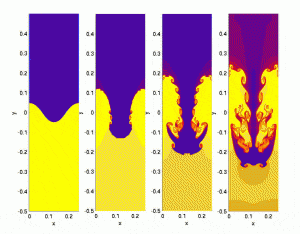Lunch Hour Lecture: From gases to gloops – instabilities in fluids
By Thomas Hughes, on 25 February 2016
Gases, gloops, waves and cloud formations: Dr Helen Wilson (UCL Mathematics) helped us explore the mathematical explanation for such instabilities in fluids in this Lunch Hour Lecture.
Waves and drips: instabilities in nature
Instabilities in fluids can be caused by a myriad of different factors. Dr Wilson talked us through a number of common instabilities that we can see in our everyday lives.
Waves and some cloud formations for example are caused by shear. This is the idea of two or more streams moving at different speeds or directions. This is called the Kelvin-Helmholtz instability and creates the familiar wave shapes as the streams push in different directions.
Some natural instabilities are caused by density. Pour a dense, gloopy fluid into a less dense fluid and through additional factors such as gravity, the denser fluid will move through the less dense fluid. This is called the Rayleigh-Taylor instability (see image).

Rayleigh Taylor Instability via Wikimedia Commons
An easy example of this is oil moving though water. Dr Wilson pointed out how much this particular instability has been a problem for oil companies. If you want to use water to push oil out of the ground “all you will get is some slightly dirty water”. Instead they use a number of methods to build pressure in the oil chamber using water, so that the oil will push itself out.
The annoying tendency of broken taps to drip, rather than have a constant trickle is caused by the Plateau-Rayleigh instability. This instability demonstrates the desire of liquids to minimise their surface area, which causes them to form into balls with the same volume as the original stream but with a smaller surface area.
The mathematical search for instabilities
Dr Wilson then talked about her work in mathematics and the search for theoretical instabilities. She uses a formula called Linear Stability Theory. The advantage of this theory is that if you find an instability, via the mathematical formulas it’s based on, you can be sure that that instability really exists in nature.
However this theory doesn’t explain why or how those instabilities form. This means that the only mathematical way to find them is to change variables in the equations in small increments and see if this creates the instability you’re looking for. Even using computer simulations this can be time consuming.
It also means that if you do find a theoretical instability, the only way to prove it exists is to run practical experiments, which due to the tiny variables involved can be difficult to do.
The long road from discovery to proof
Dr Wilson recounted her discovery of a new instability in a polymer-based solution in a shear flow. She had demonstrated mathematically that between certain very low levels of flow rate a number of instabilities appeared.
Dr Wilson published her findings, hoping to see some verification of her work, but heard nothing for 14 years. However, out of the blue a group from the French National Centre for Science contacted Dr Wilson to tell her that they had found practical evidence that the instability she had found existed.
Working with this team Dr Wilson was able to use the practical evidence to rework her theory and the equations. This enabled her to tighten the focus and find new instabilities at low flow rates.
Working with students in the UCL Mathematics department Dr Wilson has begun the search for new instabilities, however the number of possible variables makes it a time consuming search.
Why do instabilities matter?
The research into instabilities has enabled us to understand why liquids act the way they do when subjected to different variables. This sometimes has direct practical implications such as in the oil industry, but often it simply expands our understanding, and offers interesting glimpses into the unseen quirks of nature.
 Close
Close

